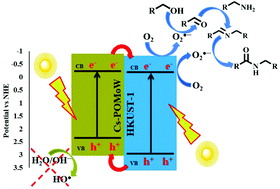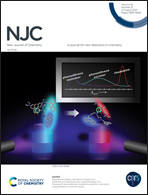Fluorinated solvent-assisted photocatalytic aerobic oxidative amidation of alcohols via visible-light-mediated HKUST-1/Cs-POMoW catalysis†
Abstract
Considering the irreplaceable importance of photocatalytic functionalization reactions and the widespread attention paid to the use of metal–organic frameworks, especially their modified variants, for this purpose in recent years, different types of HKUST-1/POMoW composites were prepared through the immobilization of a series of Keggin-type polyoxometalates (POMs; POW = H3PW12O40, POMo = H3PMo12O40, and POMoW = H3PMo6W6O40) on HKUST-1 as a metal–organic framework (HKUST-1; Cu3(1,3,5-benzenetricarboxilicacid)2). Then, to produce HKUST-1/Cs-POM, the substitution of H+ cations with Cs+ ones as counter cations was carried out. The prepared composites were fully characterized with the PXRD (powder X-ray diffraction), FT-IR (Fourier transform infrared spectroscopy), BET and BJH (sorption of N2), TGA (thermo-gravimetric analysis), SEM (scanning electron microscopy), EDX (energy dispersive X-ray), TEM (transmission electron microscopy), UV-vis DRS (diffuse reflectance UV-vis spectroscopy), photoluminescence (PL) spectroscopy and ICP-AES (inductively coupled plasma atomic emission spectroscopy) techniques. The great importance of the amide functional group and the attractiveness of photocatalytic oxidative functionalization reactions led us to study the formation of this functional group using the prepared catalytic system in line with our previous research in this field. The HKUST-1/Cs-POMoW composite showed a raised photocatalytic performance compared to the discrete components, HKUST-1 and Cs-POMs, in aerobic oxidative amidation of alcohols under illumination with visible light, owing to the presence of catalytically active Cs-POMs deposited on the MOF particles. Besides, the combination of composite components mitigated the recombination rate of the electron–hole pairs, raising its photocatalytic activity. The attractiveness of fluorine solvents for oxidation reactions has led to the study of their role in the efficiency of oxidative amidation of alcohols and their significant effect on the efficiency of the process has been confirmed. The Cu-MOF/POM catalyst showed excellent stability during the reaction, and no significant decrease in its ability was observed during five consecutive cycles.



 Please wait while we load your content...
Please wait while we load your content...